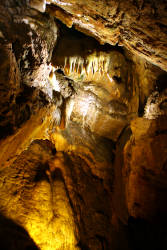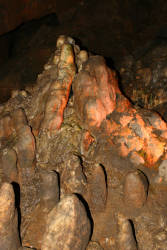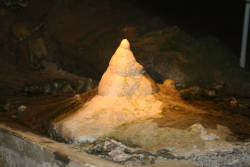Crystal Cave
Crystal Cave Park
Useful Information


| Location: |
963 Crystal Cave Road, Kutztown, PA 19530.
20 km from Cabela. I-78 exit 40 Lenhartsville, south on Rt. 143 to Virginville, left onto Crystal Cave Rd. I-222 Kutztown/Virginville exit, onto Crystal Cave Rd. Signposted. (40.525968, -75.842470) |
| Open: |
MAR to APR daily 9-17. MAY to Memorial Day Mon-Fri 9-17, Sat, Sun, Hol 9-18. Memorial Day to Labor Day Mon-Fri 9-18, Sat, Sun, Hol 9-19. Labor Day to SEP Mon-Fri 9-17, Sat, Sun, Hol 9-18. OCT to NOV daily 9-17. [2023] |
| Fee: |
Adults USD 19, Children (4-11) USD 14, Children (0-3) free. Groups (15+): Adults USD 13, Children (4-11) USD 9. [2023] |
| Classification: |
 Karst Cave
Ordovician Hamburg Klippe limestone Karst Cave
Ordovician Hamburg Klippe limestone
|
| Light: |
 Electric Light Electric Light
|
| Dimension: | T=12 °C, L=150 m. |
| Guided tours: |
D=50 min, VR=38 m. V=80,000/a [2010] |
| Photography: | |
| Accessibility: | no |
| Bibliography: |
Wayne E. Homan (1966):
The Story of Famous Crystal Cave and the Kutztown area of Pennsylvania,
Crystal Cave Co., Inc.
Kevin Patrick (2004): Pennsylvania Caves & other rocky roadside wonders, Stackpole Books, Mechanicsburg, Pa, USA, 248 pp. Ralph W Stome (1932): Pennsylvania Caves, Pennsylvania Geological Survey Fourth Series, Bulletin G3, p 19-23, survey, 2 photos. |
| Address: | Crystal Cave, R.D. 3 Box 416, 963 Crystal Cave Road, Kutztown, PA 19530-9141, Tel: +1-610-683-6765. |
| As far as we know this information was accurate when it was published (see years in brackets), but may have changed since then. Please check rates and details directly with the companies in question if you need more recent info. |
|
History
| 12-NOV-1871 | discovered by quarrying. |
| 1872 | property bought by D. F. Kohler and opened to the public. |
| 1923 | David Kohler sold the cave to Crystal Cave Co. Inc.. |
| 1923 | cave renovated. |
| 1982 | stagecoach museum opened. |
Description

Crystal Cave is, as the name suggests, famous for its speleothems.
There are stalactites, stalagmites, and pillars.
The Tobacco Leaves are so-called
 curtains, However, the crystals are calcite and aragonite crystals, which cover large portions of the cave walls.
curtains, However, the crystals are calcite and aragonite crystals, which cover large portions of the cave walls.
The cave was first discovered in 1871 by Gideon Merkel and John Gehret, two Pennsylvania Dutchmen who were working in a nearby quarry. Their first expedition was a short one, as they had no lights. They stayed at a nearby village tavern this night and told the townsfolk of their discovery. The next day the locals brought candles and coal oil lanterns to see the cave for themselves. The cave almost immediately became a popular attraction, thats why it is called Pennsylvania’s oldest show cave.
The property was bought by D. F. Kohler in 1872. He developed the cave and transported the visitors from the train stations to the cave with three stagecoaches. In 1982 a museum featuring one of those stagecoaches was opened. His son David sold the cave to Crystal Cave Co. Inc.. This company still owns and runs the cave, the co-owners are Kathy Campbell and Jim DeLong. The heyday of the cave was a few decades ago, when it attracted 130,000 visitors per year. Today it still has about 80,000 visitors and eight full-time and 40 part-time employees.
The site also offers a Nature Trail and a Geological Museum. A little off-topic are Indian Totem Poles, Miniature Golf, an authentic Amish Buggy, and a Theatre.
The first speleothem noted in this cave is a conical stalagmite called the Frozen Fountain. Here the 4 m entrance widens to 10 m but a great dropped block occupies part of the floor. The accumulation of flowstone on top of this block of limestone indicates that it has lain in its present position for thousands of years. Beyond lies The Crystal Ballroom, so-called because of the aragonite crystals which cover the speleothems. The chamber is entered by passing under The Natural Bridge, a large slab of rock which fell millions of years ago, the returning tour passes over the top of The Natural Bridge. The jumble of calcite covered boulders which makes up the floor of these two chamber are transversed by a series of steps and bridges. At one point the steps leads to a higher level and a larger room, about 12 by 50 m. The upper end offers a good view of this chamber.
Text by Tony Oldham (2005). With kind permission.
 Search DuckDuckGo for "crystal cave Kutztown"
Search DuckDuckGo for "crystal cave Kutztown" Google Earth Placemark
Google Earth Placemark Historic Crystal Cave, official website (visited: 12-JAN-2023)
Historic Crystal Cave, official website (visited: 12-JAN-2023) Crystal Cave - Atlas Obscura (visited: 12-JAN-2023)
Crystal Cave - Atlas Obscura (visited: 12-JAN-2023) Index
Index Topics
Topics Hierarchical
Hierarchical Countries
Countries Maps
Maps